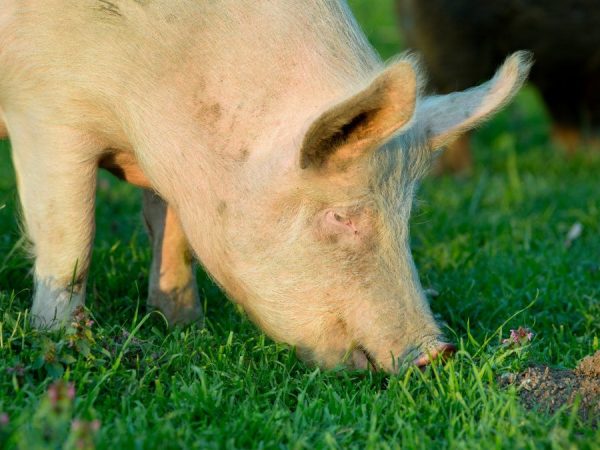Characteristics of the Yorkshire pig breed
The Yorkshire pig breed is often called bacon and is in great demand in animal husbandry both for production and for breeding.

Yorkshire pig breed
About the Yorkshire breed
In terms of productive indicators, the Yorkshire pig breed is classified as a universal one, giving an equal amount of both meat and lard. Pigs of the Yorkshire breed appeared in animal husbandry as a result of long selection and were presented to the court of English farmers in 1851 at an agricultural exhibition.
Compared to the greasy pig herd of the 19th century, Yorkshire Pigs stand out for their activity and harmony.
The popularity of animals was achieved by fixing qualitative productive characteristics at the genetic level in the process of crossing along related lines. They began to act as breeding stock for breeding other lines when crossed with Portuguese, Chinese and Italian representatives.
Animals were brought to Russia in the post-war period. Initially, Yorkshire piglets appeared on the territory of the Sverdlovsk region, then they spread towards the northwest and towards the central part of Russia.
Exterior characteristics
The characteristic of Yorkshire pigs does not place them among the largest representatives in pig production. Unlike Landrace, who by the age of six months can gain weight up to 100 kg, Yorkshires can only increase such a mass at the age of 7 months. The weight of adults is:
- boars - up to 0.32 t,
- sows - up to 0.25 tons.
The characteristics of the Yorkshire pig breed are more similar to the large white type from England, therefore they are often confused in photos and videos. The differences between representatives of different types lie in the products received from them. Whereas white English are a greasy type of pigs, Yorkshire pigs are bred in most cases for meat. The main distinguishing features of animals are light skin with practically no hair and no skin folds.
Productive differences
The breed has a number of advantages when breeding under private farming conditions:
- early maturity,
- high rates of growth intensity,
- unpretentious content,
- attribution to pasture animals, which makes it easier for farmers to raise them and becomes an additional incentive in favor of making a decision on breeding.
Products from this variety mainly consist of meat with a minimum width of a greasy layer. A pork carcass contains only up to 1.3 ccm of lard. The meat yield is up to 65%. At the same time, young animals that have reached the age of 1 year and have gained weight of 100 kg are suitable for slaughter. Adults give out fatty pork.
Russian pig breeding numbers about 1.5 million representatives of the breed. Piglets are sold at 12 breeding farms. The price for Yorkshire piglets starts from 5000 rubles.
The Yorkshire pig is ready for fertilization by ten months to one year of age.She is capable of producing a litter of 10 or more piglets, which are born large in size (up to 1 kg). By the month, young animals reach a weight of about 20 kg. When providing animals in the process of growing with full-fledged feed in an unlimited amount, their weight can be increased to 0.2 tons or more in sows and to 0.3 or more in boars by the age of 10 months.
Yorkshire pigs are widely used in the hybridization process with large white lines from England, and this type of crossing gives a high positive result in the quality characteristics of the latter.
Growing principles
The breed is bred in domestic and foreign pig breeding, thanks to the uncomplicated process of raising and keeping livestock, occupying the 4th place in terms of the prevalence of the breed. It is not uncommon to find crosses with Landraces and other lines.
Among the basic requirements for content:
- a covered room that protects animals from cold weather and drafts,
- the presence of a fenced walking area.
In the process of raising livestock, it must be remembered that this line is often sick due to violation of the conditions of detention. Among the main diseases to which these pigs are susceptible are rickets and vitamin deficiency, which are recorded in young animals born in the spring. To prevent disease, coniferous branches are introduced into the diet of animals.
Among the disadvantages of the breed, farmers indicate susceptibility to skin burns in the southern regions and the rapid accumulation of fatty deposits with intensive feeding.
The main feed ration of Yorkshire pigs and piglets consists of compound feed and grass, bran and potatoes, vegetables (radishes, zucchini, beets), cereals (millet, oats, corn).


